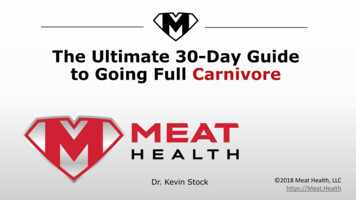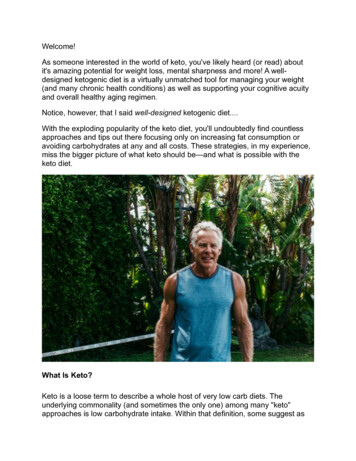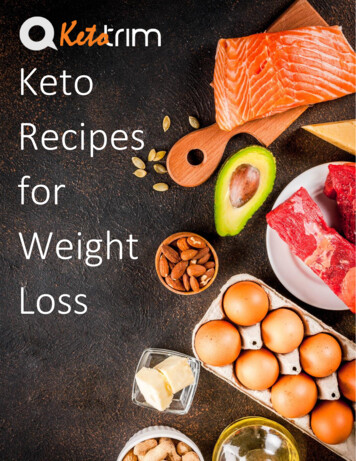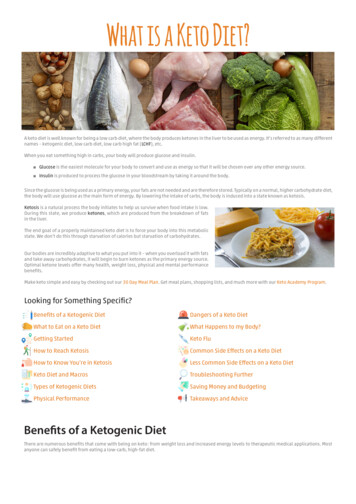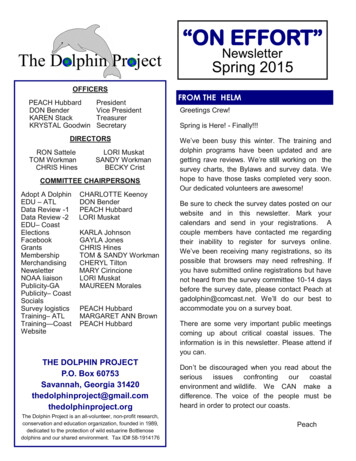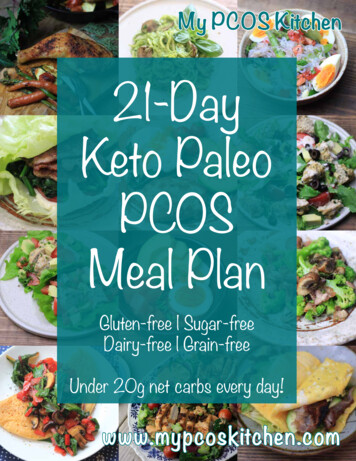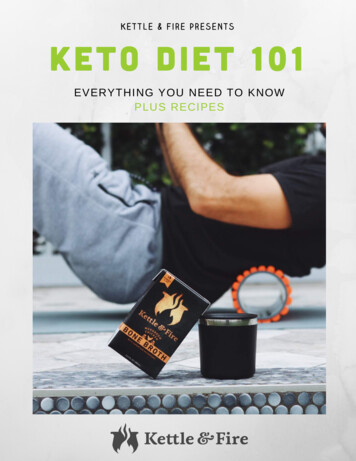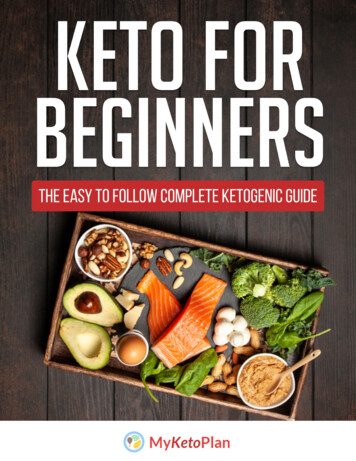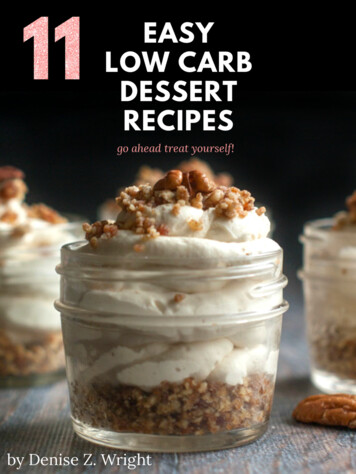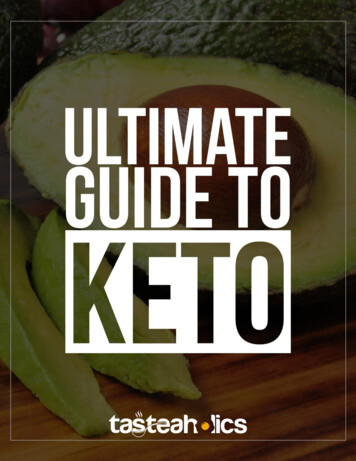
Transcription
TABLE OF CONTENTS3Disclaimer4Welcome To The Ultimate Keto Guide!5The BasicsWhat is Keto?Calories & MacronutrientsA Nutritional RevolutionBenefits Of Going KetoSteering Clear Of The Keto Flu11Introducing Our ‘In Five' Cookbooks12Starting KetoPart 1 – Out With The OldPart 2 – In With The New!Part 3 – Meal Plan16Weekly Keto Weight Loss Meal Plans17Keto Snacks Delivered To Your Door18Thank You For Reading!19On To The 14-Day Keto Meal Plan20References2
DISCLAIMERTasteaholics, Inc. is not a medical company or organization. Our Ultimate Guide to Keto and 14-Day Meal Plane-books provide information in respect to healthy eating, nutrition and recipes and are intended forinformational purposes only. We are not nutritionists or doctors and the information in this e-book and ourwebsite is not meant to be given as medical advice. We are two people sharing our success strategies andresources and encouraging you to do further research to see if they’ll work for you too. Before starting any diet,you should always consult with your physician to rule out any health issues that could arise. Safety first, resultssecond. Do not disregard professional medical advice or delay in seeking it because of this e-book.Many of the third party links throughout this publication may be affiliates links which means we will receive apercentage of sales (with no extra cost to you). Thank you for your support!Copyright 2016 by Tasteaholics, Inc.3
WELCOME TO THE ULTIMATE KETO GUIDE!This guide was designed to help you kick start your keto diet so you can lose weight, become healthy and havehigh energy levels every day.Inside, you’ll find the basics of the ketogenic diet, how to get started and how to guarantee success. We’ve alsoprovided a 14-day meal plan with full step-by-step recipes and pre-calculated nutrition data to make startingyour keto diet easier and more enjoyable.Let’s get started!4
THE BASICS5
WHAT IS KETO?The Ketogenic DietThe Truth About FatThe ketogenic (or keto) diet is a low carbohydrate,You may be thinking, “but eating a lot of fat is bad!”high fat diet. Maintaining this diet is a great tool forThe truth is, dozens of studies and meta studies withweight loss. More importantly, according to anover 900,000 subjects have arrived at similarincreasing number of studies, it reduces risk factors forconclusions: eating saturated and monounsaturateddiabetes, heart diseases, stroke, Alzheimer’s, epilepsy,fats has no effects on heart disease risks7,8.and more1-6.Most fats are good and are essential to our health.On the keto diet, your body enters a metabolic stateFats (fatty acids) and protein (amino acids) arecalled ketosis. While in ketosis your body is usingessential for survival. Read our Healthy Fats Guide forketone bodies for energy instead of glucose. Ketonemore information about different types of fat.bodies are derived from fat and are a much morestable, steady source of energy than glucose, which isderived from carbohydrates.Entering ketosis usually takes anywhere from 3 days toThere is no such thing as an“essential carbohydrate.”a week. Once you’re in ketosis, you’ll be using fat forenergy, instead of carbs. This includes the fat you eatand stored body fat.Testing For KetosisFats are the most efficient form of energy and eachgram contains more than double the energy in a gramof protein or carbohydrates (more on that later).You can test yourself to see whether you’ve enteredThe keto diet promotes eating fresh, whole foods likeketosis just a few days after you’ve begun the ketomeat, fish, veggies, and healthy fats and oils as well asdiet! Simply use a ketone test strip and it will tell yougreatly reducing processed and chemically treatedthe level of ketone bodies in your urine. If thefoods the Standard American Diet (SAD) has so longconcentration is high enough, you’ve successfullyencouraged.entered ketosis!It’s a diet that you can sustain long-term and enjoy.What’s not to enjoy about bacon and eggs in themorning?6
CALORIES & MACRONUTRIENTSHow Calories WorkNet CarbsA calorie is a unit of energy. When something containsMost low carb recipes write net carbs when displaying100 calories, it describes how much energy your bodytheir macros. Net carbs are total carbs minus dietarycould get from consuming it. Calorie consumptionfiber and sugar alcohols. Our bodies can’t break themdictates weight gain/loss.down into glucose so they don’t count toward yourIf you burn an average of 1,800 calories and eat 2,000calories per day, you will gain weight.If you do light exercise that burns an extra 300 caloriesper day, you’ll burn 2,100 calories per day, putting youat a deficit of 100 calories. Simply by eating at a deficit,total carb count.Note: Dietary fiber is sometimes listed as soluble orinsoluble.How Much Should You Eat?you will lose weight because your body will tap intoOn a keto diet, about 65 to 75 percent of the caloriesstored resources for the remaining energy it needs.you consume daily should come from fat. About 20to 30 percent should come from protein. TheThat being said, it’s important to get the right balanceof macronutrients every day so your body has theremaining 5 percent or so should come fromcarbohydrates.energy it needs.What Are Macronutrients?Macronutrients (macros) are molecules that ourYou can use our keto calculator to figure out exactlyhow many calories and which macros you should beeating every day!bodies use to create energy for themselves – primarilyfat, protein and carbs. They are found in all food andare measured in grams (g) on nutrition labels. Fat provides 9 calories per gram Protein provides 4 calories per gramKETO CALCULATORIt asks you for basic information like your weight,activity levels and goals and instantly tells you how Carbs provide 4 calories per gramRead our Macros Guide for more information.many grams of fat, protein and carbs you should beeating each day.7
A NUTRITIONAL REVOLUTIONCarbs: What Exactly Are They?Where We Are TodayCarbohydrates (carbs) are found in things likeAccording to the 2014 report by the Centers forstarches, grains and foods high in sugar. This includes,Diseases Control and Prevention (CDC), more than 1 inbut isn’t limited to, bread, flour, rice, pasta, beans,3 adults in the U.S. (86 million people) havepotatoes, sugar, syrup, cereals, fruits, bagels and soda.prediabetes, a condition in which blood glucose isCarbs are broken down into glucose (a type of sugar)in our bodies for energy. Eating any kinds of carbsalways high and commonly leads to type 2 diabetesand many other medical problems10.spikes blood sugar levels. The spike may happen fasterToday, almost 1 in 10 people in the U.S. have type 2or slower depending on the type of carb (simple ordiabetes compared to almost 1 in 40 in 1980.complex), but the spike will still happen.Fat has been blamed as the bad guy and companiesBlood sugar spikes cause strong insulin releases tohave been creating low-fat and fat-free, chemically-combat the spikes. Constant insulin releases result inladen alternatives of nearly every type of food infat storage and insulin resistance. After many years,existence, yet diabetes and heart disease rates are stillthis cycle commonly leads to prediabetes, metabolicincreasing.syndrome and even type 2 diabetes9.In a world full of sugar, cereal, pasta, burgers, Frenchfries and large sodas, you can see how carbs caneasily be overconsumed.Fat is Making a ComebackWe’re starting to understand that carbs in largequantities are much more harmful than previouslythought, while most fats are healthy and essential.The nutritional landscape is changing. Keto/low carbAlmost 1 in 10 adults in the U.S.have type 2 diabetes, nearly 4times more than 30 years ago.and similar dietary groups are growing and anutritional revolution is beginning. We are starting torealize the detrimental effects of our relationship withexcess sugar and carbs.8
THE BASICS: BENEFITS OF GOING KETOLong-Term BenefitsStudies consistently show that those who eat a lowcarb, high fat diet rather than a high carb, low fat diet: Lose more weight and body fat 11-17 Have better levels of good cholesterol (HDL andlarge LDL) 18,19Longer satiation and consistent energy levels are dueto the majority of calories coming from fat, which isslower to digest and calorically denser.Eating low carb also eliminates blood glucose spikesand crashes. You won’t have sudden blood sugardrops leaving you feeling weak and disoriented. Have reduced blood sugar and insulin resistance(commonly reversing prediabetes and type 2diabetes) 20,21Entering Ketosis Experience a decrease in appetite22ketosis all the time. If you’re just getting started with Have reduced triglyceride levels (fat molecules inthe blood that cause heart disease) 19,23your keto diet, you should eat up to 25 grams of carbs Have significant reductions in blood pressure,leading to a reduction in heart disease andstroke24The keto diet’s main goal is to keep you in nutritionalper day.Once you’re in ketosis for long enough (about 4 to 8weeks), you become keto-adapted, or fat-adapted.This is when your glycogen decreases (the glucoseEating keto/low carb helpsyou lose more weight thaneating low fat.stored in muscles and liver), you carry less waterweight, muscle endurance increases and your overallenergy levels are higher.Another benefit of being keto-adapted is that you canDay-to-Day BenefitsThe keto diet doesn’t only provide long-term benefits!When you’re on keto, you can expect to: Lose body fat Have consistent energy levels during the day Stay satiated after meals longer, with lesssnacking and overeatingeat 50 grams of net carbs a day to maintain ketosis.Type 1 Diabetes & KetoacidosisIf you have type 1 diabetes, consult with your doctorbefore starting a keto diet. Diabetic ketoacidosis(DKA) is a dangerous condition that can occur if youhave type 1 diabetes due to a shortage of insulin.9
STEERING CLEAR OF THE KETO FLUWhat is the Keto Flu?Ending the Keto FluThe keto flu happens commonly to keto dieters due toThe best way to avoid (or end) the keto flu is to addlow levels of sodium and electrolytes and has flu-likemore sodium and electrolytes to your diet. Here aresymptoms including:the most effective (and tasty) ways to get more Fatiguesodium: Headaches Adding more salt to your food Cough Drinking soup broth Sniffles Eating plenty of salty foods like bacon andpickled vegetables Irritability NauseaTry to eat more sodium as you start keto to preventthe keto flu entirely. If you do catch it, just rememberIt’s important to note that this isn’t the real flu! It’sthat it’ll go away quickly and you’ll emerge a fat-called keto flu due to similar symptoms but it is not atburning machine!all contagious and doesn’t actually involve a virus.Why Does It Happen?For more information about the keto flu, visit our KetoFlu Guide.The main cause for keto flu is your body lackingelectrolytes, especially sodium. When starting keto,you cut out lots of processed foods and eat morewhole, natural foods. Although this is great, it causes asudden drop in sodium intake.The keto flu can be avoided byconsuming enough electrolytes,especially sodium.In addition, reducing carbs reduces insulin levels,which reduces sodium stored by kidneys25.Between your reduced sodium intake and storedsodium flushed by your kidneys, you end up being lowon sodium and other electrolytes.10
INTRODUCING OUR ‘IN FIVE’ COOKBOOKSBreakfast is the most important meal to startyour day off right! With Breakfast in Five, youcan enjoy 30 low carb breakfasts likepancakes, waffles, muffins, shakes, cereal, hotpockets and much more.All recipes are up to 5 grams of carbs andonly 5 ingredients each!Lunch is often difficult to make interestingand delicious due to work and time. That’swhy we created 30 recipes that are perfect foron-the-go or home that will surely blow youaway!Enjoy savory French crepes, creamy chowder,mouthwatering casseroles and much moreevery day of the month.Dinner is the meal most often eaten at home.After a long day of work, cooking a delicious,healthy meal for your family can be a dauntingtask.Enjoy steaks, wings, lasagna, burgers, sidesand much more each made from just 5ingredients and up to 5 grams of carbs.11
STARTING KETO12
PART 1 – OUT WITH THE OLDRead Nutrition LabelsHaving tempting, unhealthy foods in your home is oneof the biggest reasons for failure when starting anydiet. To maximize your chances of success, you needto remove as many triggers as you can. This crucialstep will help prevent moments of weakness fromruining all your hard work.If you aren’t living alone, make sure to discuss withCheck the nutrition labels on all your products to seeif they’re high in carbs. There are hidden carbs in theunlikeliest of places (like ketchup and canned soups).Try to avoid buying products with dozens ofincomprehensible ingredients. Less is usuallyhealthier.your family or housemates before throwing anythingout. If some items are simply not yours to throw out,try to compromise and agree on a special location soyou can keep them out of sight.For example:Starches and GrainsDeli ham can have 2 or 3Get rid of all cereal, pasta, bread, rice, potatoes, corn,oats, quinoa, flour, bagels, rolls, croissants and wraps.grams of sugar per sliceas well as many addedpreservatives and nitrites!All Sugary ThingsThrow away and forget all refined sugar, fruit juices,desserts, fountain drinks, milk chocolate, pastries,candy bars, etc.LegumesAlways check the serving sizes against the carbcounts. Manufacturers can sometimes recommendinconceivably small serving sizes to seemingly reduceDiscard or donate any beans, peas, and lentils.calorie and carb numbers.Vegetable & Seed OilsAt first glance, something may be low in carbs, but aStop using any vegetable oils and seed oils likeproduct is mostly sugar. Be diligent!quick comparison to the serving size can reveal thesunflower, safflower, soybean, canola, corn andgrapeseed oil. Get rid of trans fats like margarine.13
PART 2 – IN WITH THE NEW!Now that you’ve cleaned out everything you don’tneed, it’s time to restock your pantry and fridge withdelicious and wholesome, keto-friendly foods that willhelp you lose weight, become healthier, and feelamazing!General Products to HaveWith these basics in your home, you’ll always be readyto make healthy, keto-friendly meals. Lots of water, coffee, and unsweetened tea Stevia and erythritol (sweeteners) Condiments like mayonnaise, mustard, pesto,and srirachaVegetablesEat plenty of non-starchy veggies including asparagus,mushrooms, broccoli, cucumber, lettuce, onions,peppers, cauliflower, tomatoes, garlic, Brussels sproutsand zucchini.DairyYou can eat full-fat dairy like sour cream, heavy(whipping) cream, butter, cheeses and unsweetenedyogurt.Although not dairy, unsweetened almond milk andcoconut milk are both good milk substitutes. Broths (beef, chicken, bone)Stay away from regular milk, skim milk and sweetened Pickles and other fermented foodsyogurts because they contain a lot of sugar. Avoid all Seeds and nuts (chia seeds, flaxseeds, pecans,almonds, walnuts, macadamias, etc.)Meat, Fish & Eggsfat-free and low-fat dairy products.Oils and FatsOlive oil, avocado oil, butter and bacon fat are greatJust about every type of fresh meat and fish is goodfor cooking and consuming. Avocado oil is best forfor keto including beef, chicken, lamb, pork, salmon,searing due to its very high smoke point (520 F).tuna, etc. Eat grass-fed and/or organic meat and wildcaught fish whenever possible.Eat as many eggs as you like, preferably organic fromfree-range chickens.FruitsBerries like strawberries, blueberries, raspberries, etc.are allowed in small amounts. Avocados are greatbecause they’re low carb and very high in fat!14
PART 3 – MEAL PLAN14 Delicious Days!To get you started with your diet, we’ve created a 14day keto meal plan with delicious recipes for you toStaple recipes are critical forsuccess in your keto diet!enjoy every single day!Using a meal plan when you start the keto diet cangreatly help you succeed. If you know what’s comingup next, you’re much less likely to give up and orderfood from your favorite takeout restaurant.We’ve also included macronutrient and calorie countsand leftovers to take the guesswork out and make thestart of your keto diet a breeze!Customizing Your Meal PlanThe daily caloric goal in the meal plan is about 1600calories, give or take 100 calories.If you need to eat more or fewer calories per day, youcan adjust accordingly by simply taking out or addinga bit more of the ingredients already included in arecipe. For example, adding/removing a tablespoon ofolive oil or butter will add/remove about 100 calories.If you like or dislike certain recipes, feel free to shiftLife After Meal PlanOur hopes are that you like a few recipes so muchthey become staples in your diet. Staples are criticalfor success because they’re something you can getreally excited about multiple times a week!You should continue to try new recipes every week.You’ll get more familiar with ingredients, your owntaste buds and will be surprised by just how goodsome things are! Soon enough, you’ll be trying toconvince your friends and family to try what you’reeating because they’re missing out on how deliciousyour lifestyle has become!You can find many more delicious recipes on ourwebsite, Tasteaholics, Reddit’s /r/ketorecipes subredditand other great low carb websites!‘In Five’ Cookbook Seriesthings around. Make sure to keep an eye on theWe created a cookbook series dedicated to makingcalories so you’re still falling within an acceptablelow carb recipes extremely simple with only 5range of your daily goal.ingredients and up to 5 grams of net carbs each.Although the meal plan is for two weeks, you canCheck outeasily extend and reuse it as many times as you like.and Dessert in Five are coming soon.and! Lunch15
WEEKLY KETO WEIGHT LOSS MEAL PLANSOur Meal Plan Won’t Last Forever!That's why you'd be thrilled to know you can get new keto weight loss meal plans every week! Get precalculated, low carb meal plans and recipes right into your inbox – no more hunting down recipes on theinternet and trying to fit them together perfectly every day.The keto diet has never been easier – and you can try it totally free!Why We Love These Meal Plans Comprehensive, easy-to-follow low carb mealplans straight to your email inbox every week Easy, delicious and practical recipes (hello,tasty leftovers!) keto-friendly snack ideas Seasonal ingredients and relevant recipes All nutritional information provided Shopping lists categorized by food type Technical support for any issues that may arise Cancel at any time for free - no questionsasked!Each subscription comes with a 7-day FREE trial andyou can cancel at any time - no questions asked!16
KETO SNACKS DELIVERED TO YOUR DOORWant Keto Snacks?Our friends over at Keto Krate have taken theguesswork out of snacking on keto! They gather thebest low carb snacks from all over the world and bringthem together in a delicious monthly box deliveredright to your door! Everything is made with highquality ingredients.All products are gluten-free, aspartame-free andmaltitol-free!It’s an amazing way to discover new products that areketo-friendly and healthy. We’ve been subscribed toKeto Krate since they first started and have written areview every month if you’d like to see more (it’s like aYou can get 15% off your first boxketo Christmas at the start of every month!).just for being a Tasteaholic! Use theYou can also check out their previous boxes on theircode “KRATEAHOLICS” and get yourwebsite directly.first box today!17
THANK YOU FOR READING!Thank you for reading our Ultimate Guide to Keto and 14-Day Keto Meal Plan! We truly hope you found thisbook informative and helpful in your journey on the keto diet.If you feel it has been beneficial to you, the greatest compliment for us is to be shared! Simply click one (ormore) of the icons below to share it on your social media account(s) or by email:Or share this keto-ebook/If you want more great low carb recipes and information on the low carb diet, be sure to check out our website,Tasteaholics.com. We have dozens of articles and hundreds of low carb recipes for you to choose from and try!If you'd like to get recipe and keto diet updates on social media, be sure to follow us on:Facebook - Twitter - Pinterest - InstagramDo you have questions, comments or recipe ideas? Send us an email at hello@tasteaholics.com. We'd love tohear from you!Happy keto-ing,Rami Abramov & Vicky Ushakova!18
ON TO THE 14-DAY KETO MEAL PLAN19
REFERENCES1.Aude, Y., A. S, Agatston, F. Lopez-Jimenez, et al. “The National Cholesterol Education Program Diet vs a Diet Lower in Carbohydrates and Higher in Protein andMonounsaturated Fat: A Randomized Trial.” JAMA Internal Medicine 164, no. 19 (2004): 2141–46. doi: 10.1001/archinte.164.19 .2141 .jamanetwork.com/journals/jamainte rna lmedicine/a rtic le-abstract/21751 4.2.De Lau, L. M., M. Bornebroek, J. C. Witteman, A. Hofman, P. J. Koudstaal, and M. M. Breteler. “Dietary Fatty Acids and the Risk of Parkinson Disease: The RotterdamStudy.” Neurology 64, no. 12 (June 2005): 2040–5. doi:10.1212/01.WNL.00001 66038 .67153 .9 F. www.ncbi.nlm.nih.gov/pubmed/159 85568 /.3.Freeman, J. M., E. P. Vining, D. J. Pillas, P. L. Pyzik, J. C. Casey, and L M. Kelly. “The Efficacy of the Ketogenic Diet-1998: A Prospective Evaluation of Intervention in 150Children.” Pediatrics 102, no. 6 (December 1998): 1358–63. www.ncbi.nlm.nih.go v/pubme d/9 832569 /.4.Hemingway, C, J. M. Freeman, D. J. Pillas, and P. L. Pyzik. “The Ketogenic Diet: A 3- to 6-Year Follow-up of 150 Children Enrolled Prospectively. Pediatrics 108, no. 4(October 2001): 898–905. www.ncbi.nlm.nih.gov/pubmed/115 81442 /.5.Henderson, S. T. “High Carbohydrate Diets and Alzheimer’s Disease.” Medical Hypotheses 62, no. 5 (2014): 689–700. doi:10.1016/j.mehy.2003.11.028.www.ncbi.nlm.nih.go v/pubme d/1 508209 1/.6.Neal, E.G., H. Chaffe, R. H. Schwartz, M. S. Lawson, N. Edwards, G. Fitzsimmons, A. Whitney, and J. H. Cross. “The Ketogenic Diet for the Treatment of Childhood Epilepsy:A Randomised Controlled Trial.” Lancet Neurology 7, no. 6 (June 2008): 500–506. doi:10.1016/S1474-4422(08 )7009 2-9. www.ncbi.nlm.nih.gov/pubme d/18 456557 .7.Chowdhury, R., S. Warnakula, S. Kunutsor, F. Crowe, H. A. Ward, L. Johnson, et al. “Association of Dietary, Circulating, and Supplement Fatty Acids with Coronary Risk: ASystematic Review and Meta-Analysis.” Annals of Internal Medicine 160 (2014): 398–406. doi:10.7326/M13-1788. annals.org/article.aspx?a rticle id 1846 638.8.Siri-Tarino, P. W., Q. Sun, F. B. Hu, and R. M. Krauss. “Meta-Analysis of Prospective Cohort Studies Evaluating the Association of Saturated Fat with CardiovascularDisease.” American Journal of Clinical Nutrition 91, no. 3 (March 2010): 535–46. doi:10.3945/ajcn.2009.27725. www.ncbi.nlm.nih.gov/pubmed/200 71648 .9.“Prediabetes and Insulin Resistance,” The National Institute of Diabetes and Digestive and Kidney Diseases. https://www.niddk.nih.gov/he althinformation/diabetes /types/prediabetes-insulin-resistance.10. “National Diabetes Statistics Report,” Centers for Disease Control and Prevention, 2014. http://www.cdc.gov/diabe tes/pubs/statsreport1 4/nationa l-diabetes-repo rtweb.pdf.11. Dyson, P. A., Beatty, S. and Matthews, D. R. “A low-carbohydrate diet is more effective in reducing body weight than healthy eating in both diabetic and non-diabeticsubjects.” Diabetic Medicine. 2007. 24: 1430–1435. http://onlinelibrary.wiley.com/doi/10.1111 /j.1464-5 491.2 007.0 2290.x/full.12. Christopher D. Gardner, PhD; Alexandre Kiazand, MD; Sofiya Alhassan, PhD; Soowon Kim, PhD; Randall S. Stafford, MD, PhD; Raymond R. Balise, PhD; Helena C.Kraemer, PhD; Abby C. King, PhD, "Comparison of the Atkins, Zone, Ornish, and LEARN Diets for Change in Weight and Related Risk Factors Among OverweightPremenopausal Women," JAMA. 2007;297(9):969-977. http://jama.jamanetwork.com/article.aspx?artic leid 205916 .13. Gary D. Foster, Ph.D., Holly R. Wyatt, M.D., James O. Hill, Ph.D., Brian G. McGuckin, Ed.M., Carrie Brill, B.S., B. Selma Mohammed, M.D., Ph.D., Philippe O. Szapary, M.D.,Daniel J. Rader, M.D., Joel S. Edman, D.Sc., and Samuel Klein, M.D., "A Randomized Trial of a Low-Carbohydrate Diet for Obesity — NEJM," N Engl J Med 2003; 348:20822090. http://www.nejm.org/doi/full/10.1056 /NEJMoa022 207.14. JS Volek, MJ Sharman, AL Gómez, DA Judelson, MR Rubin, G Watson, B Sokmen, R Silvestre, DN French, and WJ Kraemer, "Comparison of Energy-restricted Very Lowcarbohydrate and Low-fat Diets on Weight Loss and Body Composition in Overweight Men and Women," Nutr Metab (Lond). 2004; 1: 13.http://www.ncbi.nlm.nih.go v/pmc /articles/PMC5382 79/ .15. Y. Wady Aude, MD; Arthur S. Agatston, MD; Francisco Lopez-Jimenez, MD, MSc; Eric H. Lieberman, MD; Marie Almon, MS, RD; Melinda Hansen, ARNP; Gerardo Rojas,MD; Gervasio A. Lamas, MD; Charles H. Hennekens, MD, DrPH, "The National Cholesterol Education Program Diet vs a Diet Lower in Carbohydrates and Higher in Proteinand Monounsaturated Fat," Arch Intern Med. 2004;164(19):2141-2146. http://archinte.jamanetwork .com/a rticle.aspx?artic leid 217514 .16. Bonnie J. Brehm, Randy J. Seeley, Stephen R. Daniels, and David A. D’Alessio, "A Randomized Trial Comparing a Very Low Carbohydrate Diet and a Calorie-Restricted LowFat Diet on Body Weight and Cardiovascular Risk Factors in Healthy Women," The Journal of Clinical Endocrinology & Metabolism : Vol 88, No 4; January 14, 2009.http://press.endocrine.org/doi/full/10.1210 /jc.2002-02 1480.17. M. E. Daly, R. Paisey, R. Paisey, B. A. Millward, C. Eccles, K. Williams, S. Hammersley, K. M. MacLeod, T. J. Gale, "Short-term Effects of Severe Dietary Carbohydraterestriction Advice in Type 2 Diabetes—a Randomized Controlled Trial," Diabetic Medicine, 2006; 23: 15–20. http://onlinelibra ry.wile y.com /do i/10 .1111 /j.146 45491.2005.01760.x/abstract .18. Stephen B. Sondike, MD, Nancy Copperman, MS, RD, Marc S. Jacobson, MD, “Effects Of A Low-Carbohydrate Diet On Weight Loss And Cardiovascular Risk Factor InOverweight Adolescents,” The Journal of Pediatrics: Vol 142, Issue 3: 253-258; March 2003. http://www.sciencedirect.com/scie nce/a rtic le/pii/S00 223476 024020 65.19. William S. Yancy Jr., MD, MHS; Maren K. Olsen, PhD; John R. Guyton, MD; Ronna P. Bakst, RD; and Eric C. Westman, MD, MHS, "A Low-Carbohydrate, Ketogenic Dietversus a Low-Fat Diet To Treat Obesity and Hyperlipidemia: A Randomized, Controlled Trial," Ann Intern Med. 2004;140(10):769-777.http://annals.org/article .aspx?a rticle id 7174 51.20. Grant D Brinkworth, Manny Noakes, Jonathan D Buckley, Jennifer B Keogh, and Peter M Clifton, "Long-term Effects of a Very-low-carbohydrate Weight Loss DietCompared with an Isocaloric Low-fat Diet after 12 Mo," Am J Clin Nutr July 2009 vol. 90 no. 1 23-32. http://ajcn.nutritio n.org/content/90 /1 /23.long .21. H. Guldbrand, B. Dizdar, B. Bunjaku, T. Lindström, M. Bachrach-Lindström, M. Fredrikson, C. J. Östgren, F. H. Nystrom, "In Type 2 Diabetes, Randomisation to Advice toFollow a Low-carbohydrate Diet Transiently Improves Glycaemic Control Compared with Advice to Follow a Low-fat Diet Producing a Similar Weight Loss," Diabetologia(2012) 55: 2118. http://link.springer.com/a rticle /10.1 007/s00 125-012- 2567-4 .22. Sharon M. Nickols-Richardson, PhD, RD, , Mary Dean Coleman, PhD, RD, Joanne J. Volpe, Kathy W. Hosig, PhD, MPH, RD, "Perceived Hunger Is Lower and Weight Loss IsGreater in Overweight Premenopausal Women Consuming a Low-Carbohydrate/H igh- Protein vs High-Carbohydrate/Low- Fat Diet," The Journal of Pediatrics: Vol 105,Issue 9: 1433–1437; September 2005. http://www.sciencedirect.com /science /article/pii/S0002 822305 01151X .23. Frederick F. Samaha, M.D., Nayyar Iqbal, M.D., Prakash Seshadri, M.D., Kathryn L. Chicano, C.R.N.P., Denise A. Daily, R.D., Joyce McGrory, C.R.N.P., Terrence Williams,B.S., Monica Williams, B.S., Edward J. Gracely, Ph.D., and Linda Stern, M.D., "A Low-Carbohydrate as Compared with a Low-Fat Diet in Severe Obesity, " N Engl J Med2003; 348:2074-2081. http://www.nejm.org/do i/full/10.1 056/NEJMoa0226 37.24. Yancy WS Jr, Westman EC, McDuffie JR, Grambow SC, Jeffreys AS, Bolton J, Chalecki A, Oddone EZ, “A randomized trial of a low-carbohydrate diet vs orlistat plus a lowfat diet for weight loss,” Arch Intern Med. 2010 Jan 25;170(2):136-45.http://www.ncbi.nlm.nih.go v/pubme d/2 010100 8?ito ol EntrezS ystem2.PEntrez.P ubme d.P ubme d ResultsPane l.P ubmed RVDocS um&o rdina lpos 2.25. Swasti Tiwari, Shahla Riazi, and Carolyn A. Ecelbarger, “Insulin’s Impact on Renal Sodium Transport and Blood Pressure in Health, Obesity, and Diabetes,” AmericanJournal of Physiology vol. 293, no. 4 (October 2, 2007): 974–984, http://ajprenal.physio log y.o rg/co nte nt/293/4/F974 .full .20
The ketogenic (or keto) diet is a low carbohydrate, high fat diet. Maintaining this diet is a great tool for weight loss. More importantly, according to an increasing number of studies, it reduces risk factors for diabetes, heart diseases, stroke, Alzheimer’s, epilepsy, and more. 1-6. On the keto diet, your body enters a metabolic state .File Size: 2MB
